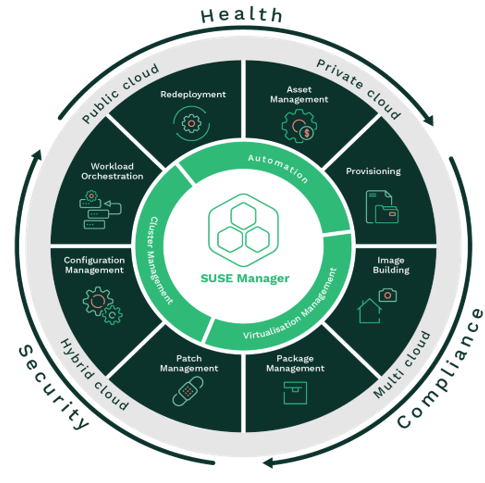SUSE Manager 4.2 is now generally available, with the open source infrastructure management tool adding improved support for public cloud workloads (including support for Amazon Linux 2 and Alma Linux 8) and new features including welcome Ansible integration in a bid to broaden its market share and make sure traditional customers shifting workloads to the cloud remain on board.
SUSE Manager 4.2 -- designed as a central hub to handle everything from remote installation to cloud orchestration, automatic updates, custom configuration, performance monitoring, compliance and security audits -- now supports SLES, RHEL, openSUSE, Oracle Linux, CentOS, Alma Linux, Ubuntu, Debian, and Alibaba Cloud Linux. The idea: let IT admins setup, manage Linux setups for bare metal, containers or VMs, using AutoYaST or Kickstart and scale to 100,000s of nodes from edge to data center or cloud.
The Ansible integration is a major move for SUSE and means users don't need to re-implement Ansible automation tools if they want to run SUSE Manager 4.2 -- which lets end-users simply re-use and run their Ansible playbooks. By letting customers consolidate tools while keeping existing automation investments SUSE aims to make migration easier for customers. (Ansible is an open source software provisioning, configuration management, and application-deployment tool sponsored by Red Hat and typically used for smaller IT infrastructure environments than SUSE Manager 4.2 is targeting.)
Other improvements include easier VM configuration through the UI. Tuning parameters will include CPU pinning and memory settings to name but a few, SUSE's Jason Phippen notes. It's not the kind of tool that gets much hot press, but as an engine to run enterprise DevOps and IT operations, support CI/CD, and handle automated deployment of hardened OS templates (either VMs or containers) to tens of thousands of servers, it deserves recognition.
Interesting, SUSE Manager 4.2 also adds initial support for SLE Micro: its tiddly lightweight OS built for edge computing, as it eyes a nascent edge market. (SLE Micro can run on x86-64 and AArch64 hardware architectures and is security hardened in an edge/IoT world that's still rife with Swiss cheese-level software.)
Aside from SUSE Manager 4.2, what's going on at SUSE anyway?

SUSE, despite swapping hands multiple times over the years (it was most recently bought from Micro Focus by private equity firm EQT for $2.5 billion -- the sale completed in March 2019) and then listed by EQT on Frankfurt's exchange in March 2021, has not quite built the head of steam some would expect.
Its deal to buy Kubernetes management platform provider Rancher Labs for a reported $600 million in late 2020 gave it further impetus and EQT says it grew 17% on-year in 2020, with 98% of revenues from recurring subscriptions.
(As Sacha Labourey, the president of DevOps and CI/CD platform provider CloudBees put it to The Stack's founder Ed Targett in late 2020: “Rancher was the last independent K8s distribution with adoption. What’s interesting is that now we are facing a match of three Enterprise Software distributions, VMWare, Red Hat and SUSE, vs. three Enterprise Services, Google, AWS and Microsoft. Two completely distinct worlds. With the first one advocating to be cloud-agnostic and able to operate on-premises but at a hefty price, while the second one promising the best ROI ever: no management, no upgrade and a close to zero price tag – since you pay for the infrastructure. And with that second group, increasingly offering « remote SaaS » that can be installed on-premises, this is going to be a very interesting situation to watch.)









